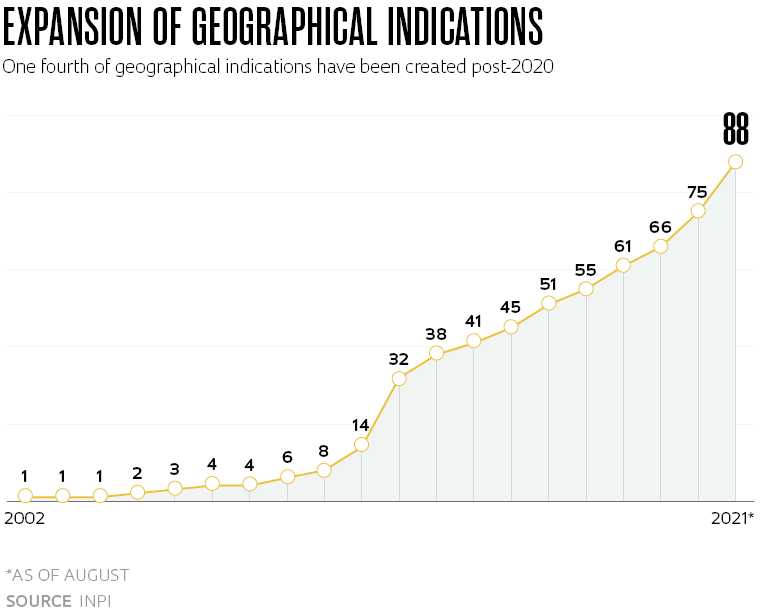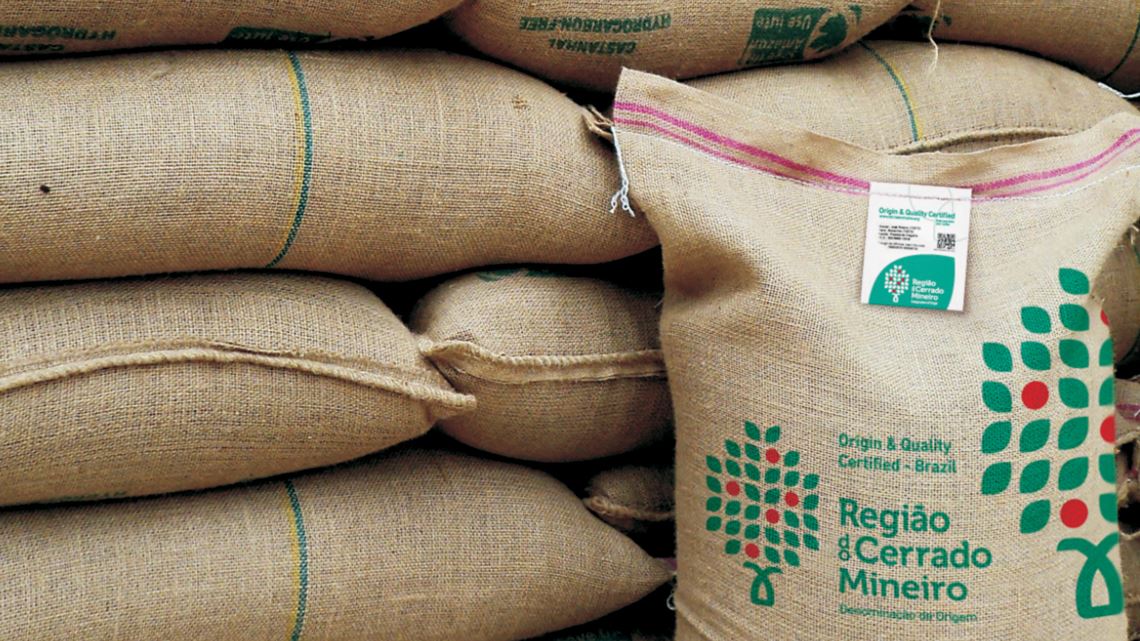One fourth of Brazil’s GIs have been recognized in or after 2020, adding momentum to a gradual process that began two decades ago. “Another 27 IG applications are undergoing technical review,” says Pablo Regalado, head of the INPI department tasked with reviewing these types of applications. It currently takes an average of 20 months for the INPI to issue its first opinion, favorable or otherwise, on recognizing a new GI. The law creating Brazil’s geographical indication framework was enacted in 1996. The country’s first geographical indication would only be recognized six years later. In 2002, a GI was granted for wines and sparkling wines produced in an upland area of Rio Grande do Sul known as Vale dos Vinhedos, or “Vineyard Valley.”
Other geographical indications have since been recognized for products such as coffee, cheese, honey, fruits, seafood, meats, and wine. Dimension stone products can also receive GI protection—three of the four GIs in Rio de Janeiro are for dimension stone (the other is for Paraty cachaça). “Under Brazilian law, applications for GI protection can be made even for handicrafts and services,” notes Kelly Bruch, a professor of commercial, business, and labor law at the Federal University of Rio Grande do Sul (UFRGS) and an expert in Brazilian GI legislation. France now also recognizes GI protection for handicrafts. Brazil’s geographical indication framework drew inspiration from European legislation designed to promote and protect agricultural products made with ingredients or using techniques that are typical of a specific location (see sidebar).
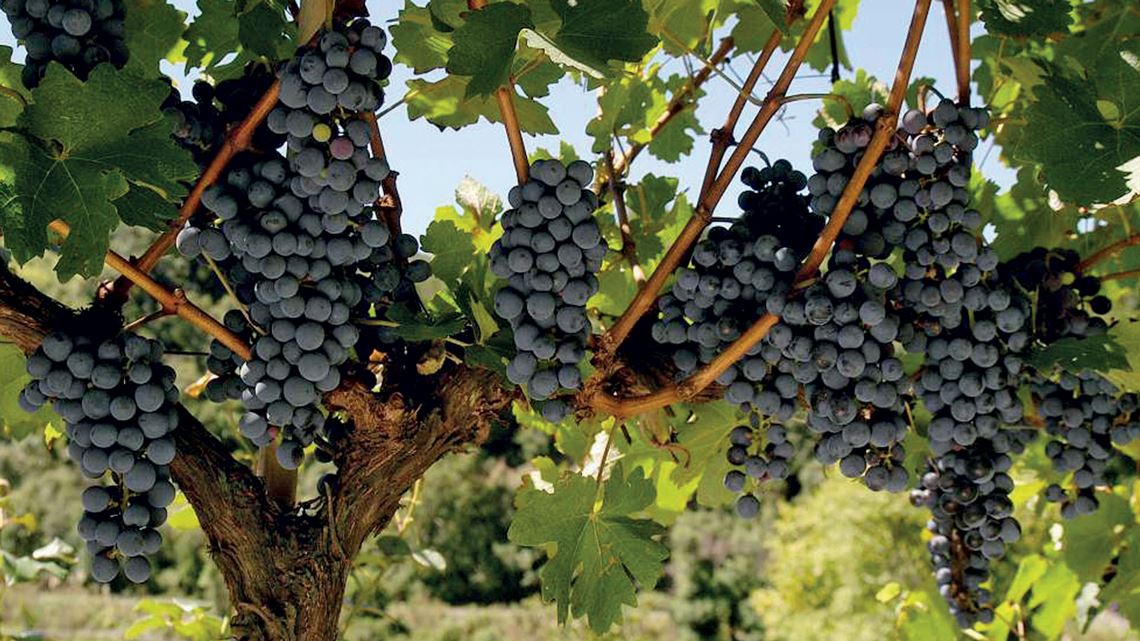
Gilmar Gomes / Aprovale
A vineyard in
Vale dos Vinhedos: nearly half a million tourists visit the region each year
Gilmar Gomes / AprovaleThe two types of GI protection carry similarities as well as differences. Both protected geographical indications and protected designations of origin establish rules on how a given product is made by producers within a delimited geographical area. A protected product must be produced in accordance with a series of guidelines that can be either relatively generic or highly restrictive. Producers that follow these guidelines, as outlined in a set of technical specifications, are eligible to use the relevant PGI or PDO label on their products. An internal regulatory board is tasked with enforcing GI standards. Although the INPI will typically award a PGI or PDO to a given legal entity (often a trade association, cooperative or union), local producers that are not members of that association are permitted to use the geographical indication on their products if they are compliant with the relevant GI requirements.
A GI designation covers a given location, not necessarily confined to an administrative division. It can be a geographic feature such as mountain range or a river, or a region or city that is famous for a given product. “The geographic area needs to be demonstrated to be linked to the GI-protected product,” explains Débora Gomide Santiago, a veterinarian who heads the geographical indication department for agricultural products at the Ministry of Agriculture and Food Supply (MAPA).
Applicants for protected geographical indications, a GI subcategory in Brazil, are not required to demonstrate that their product derives its properties from the geographic features of its place of origin or from any production techniques that are typical of that region. They simply need to show that a given area has a long history of, and has built a reputation for, producing a given product. “They need to demonstrate, through desktop research, that the area has become famous for making a given product,” explains Bruch.
For protected designations of origin, another category of geographical indications, the requirements are much more exacting. “Applicants need to show that their product derives its properties from natural factors such as climate, soil, and terrain, and from the techniques and know-how developed by producers in the relevant region,” explains Jorge Tonietto, a crop scientist at the Grape & Wine chapter of the Brazilian Agricultural Research Corporation (EMBRAPA), who helped to develop the geographical indication applications for seven types of wine produced in Rio Grande do Sul. Tonietto, an expert in climate zoning for viticulture, is a leading authority on compiling technical information to support PGI and PDO applications.
Brazil’s first geographical indication, Vale dos Vinhedos, provides a good illustration of how a GI scheme works for an area known for its wines and sparkling wines. The region, located in Rio Grande do Sul, southern Brazil, was recognized as a protected geographical indication in 2002 and then upgraded to protected designation of origin in 2012. The valley covers an area of 72 square kilometers (km2) spanning three different municipalities. Bento Gonçalves contains 61% of the GI area, Garibaldi contains 34%, and Monte Belo do Sul 5%. The Vale dos Vinhedos PDO specifications require red wines to be produced entirely or primarily with Merlot grapes. White wines are required to be made primarily with Chardonnay grapes.
Sparkling wines must be made with at least 60% Chardonnay and/or Pinot Noir grapes and using traditional methods similar to those employed in France to produce Champagne. “All grapes used in PDO-labeled wines must be grown within Vale dos Vinhedos,” notes Tonietto. Can producers make wines with other grapes and using other methods in this region of Rio Grande do Sul? Sure (and many do). But those products are not eligible to carry the PDO label. Vale dos Vinhedos has often been used as a case study for other geographical indications in Brazil (see sidebar).
The coffee sector, once a mainstay of Brazil’s economy, has been awarded 13 geographical indications, the largest number in the country—including 8 protected geographical indications and 5 protected designations of origin. The Matas de Rondônia PDO, approved in June this year, is the most recently granted geographical indication in Brazil. The area covers 17 municipalities in Amazonas known for their production of Robusta coffee (Coffea canephora), a species with a more rustic taste profile than higher valued Arabica coffee (Coffea arabica).
Six states grow coffee within GI-protected areas. “For coffee producers, a geographical indication has a similar effect to other types of labels that are prized in the market, such as fair trade, with the advantage that the certification process is cheaper and, at least for now, less reliant on external audits,” says Flávia Bliska, a crop scientist at the Alcides de Carvalho Coffee Center at the Campinas Institute of Agriculture (IAC).
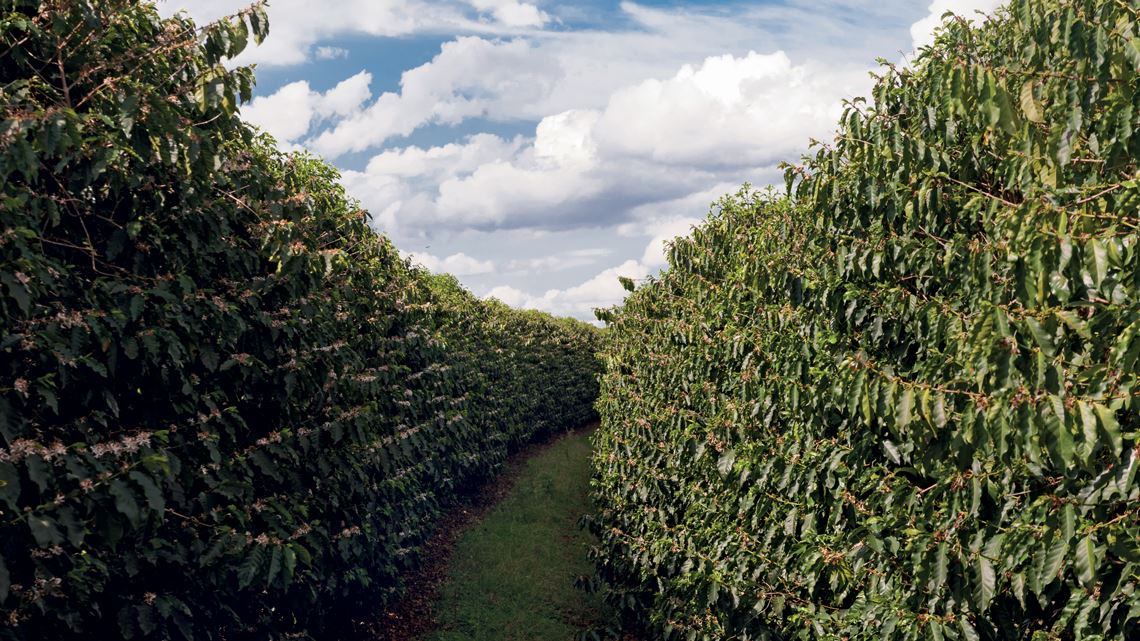
Luca Dambros
A coffee plantation in Alta Mogiana, an area with protected geographical indication status in São Paulo State
Luca DambrosBliska is currently doing research on management practices at coffee companies in São Paulo and other states. Even in regions that have been awarded geographical indications, product quality is not always good. “I know farmers in Caparaó, on Minas Gerais’s border with Espírito Santo, who harvest a large proportion of their coffee cherries green, and fail to dry the coffee beans properly, which often leads to mold,” says Bliska.
São Paulo has two GI-protected areas producing Arabica coffee: the Alta Mogiana PGI and the Região do Pinhal PGI. The first, recognized in 2013, covers municipalities surrounding Franca. The second was created in 2016 and includes the municipalities of Espírito Santo do Pinhal, Santo Antônio do Jardim, Aguaí, São João da Boa Vista, Águas da Prata, Estiva Gerbi, Mogi Guaçu, and Itapira. “We decided to apply for a geographical indication to promote our region and coffee growers here,” says Gabriel Borges, a director at Alta Mogiana Specialty Coffees (AMSC), an association of 90 coffee growers. The association is considering applying for an expansion of the coverage area to include other municipalities in Minas Gerais and São Paulo. The region produces 4–5 million 60-kilo bags of coffee per year, more than half of which are exported.
“Geographical indications are also a way to protect against fraud and add value to our product,” says Juliano Tarabal, head of the Cerrado Coffee Growers’ Federation, which obtained a PGI in 2005, the second to be awarded in Brazil. In 2013 the Cerrado Mineiro, an area comprising 55 municipalities, was also recognized as a PDO. The area produces around 6 million bags of Arabica coffee, of which 70% is sold to international markets.
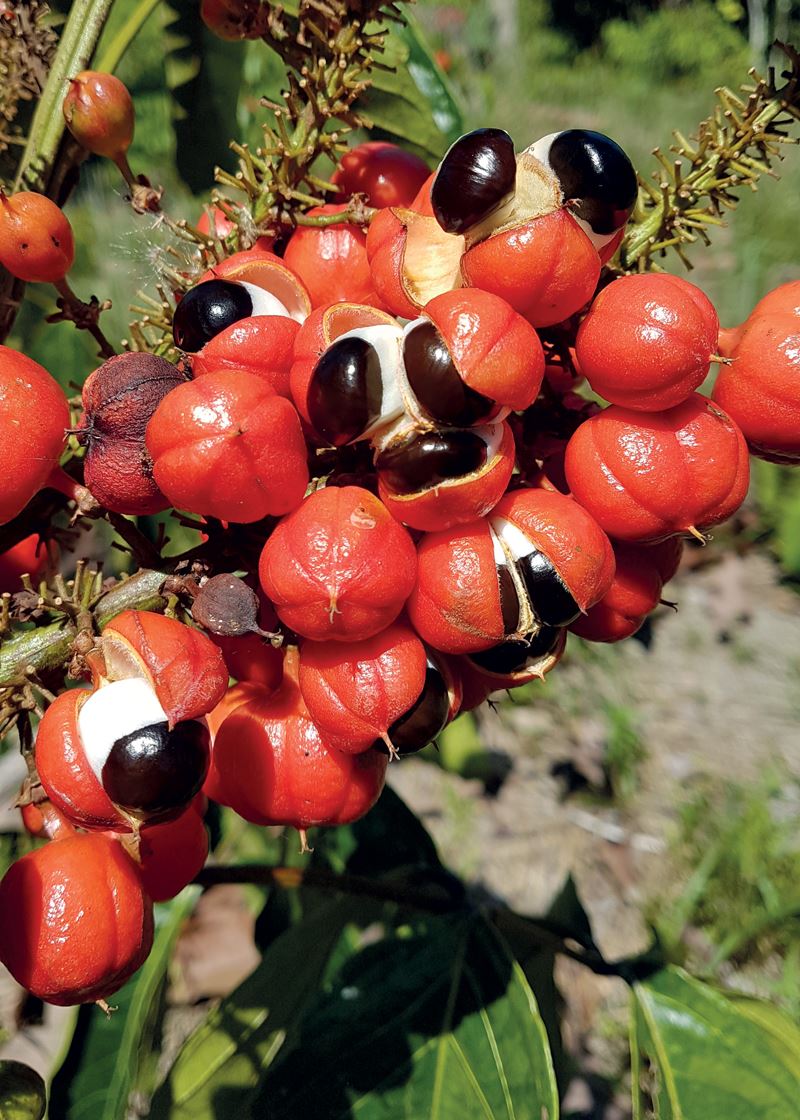
Léo Ramos Chaves
GI status has been granted to two guarana regions: the Amazon municipality of Maués, and the Andirá-Marau Indian Reservation, on the border between the states of Amazonas and Pará
Léo Ramos ChavesArtisanal cheeses with geographical indications have also gained recognition and popularity among Brazilian consumers. Five geographical indications have been created: four PGIs (Canastra and Serro, in Minas Gerais, Colônia Witmarsum, in Paraná, and Marajó, in Pará) and one PDO (Serrano artisanal cheese, produced along the border between Santa Catarina and Rio Grande do Sul). Canastra, perhaps Brazil’s best-known artisanal cheese, is made from raw cow’s milk in seven municipalities located in an upland area, Serra da Canastra, from which the cheese takes its name. Canastra has become a value-added alternative to producing the more commercial Minas Frescal cheese. “A minimum ripening period of 14 days makes Canastra cheese a more complex and premium product,” explains Júnio Cesar de Paula, a researcher at the Cândido Tostes Dairy Institute of the Minas Gerais Agricultural Research Company (EPAMIG), in Juiz de Fora.
A piece of Minas Frescal cheese weighing approximately 1 kilo, sold within one or two days of production, costs around R$15, roughly four times less than an equivalently sized piece of Canastra cheese, says de Paula. “We received a visit from French cheese producers in the early 2000s and they encouraged us to apply for a geographical indication,” says Higor Freitas, who manages the Canastra Cheese Producers’ Association (APROCAN). Production of Canastra cheese has yet to become widely established in the region. Out of around 800 local cheese producers—largely small, family-run operations producing around 20 cheeses per day—only 70 are members of APROCAN and regularly label their products as Canastra cheese.
Last October, the first geographical indication was approved for products made on an Indian reservation protected by the National Indian Foundation (FUNAI). The Andirá-Marau Indian Reservation was recognized as a protected designation of origin on behalf of the Sateré-Mawé Producers’ Consortium (CPSM). Members of this ethnicity can use this designation on guarana (Paullinia cupana) grown in the mid-Amazon River basin, along the border between the states of Amazonas and Pará. The Indian reservation covers an area of 7,890 km2 and includes parts of the municipalities of Aveiro, Itaituba, and Juruti, in Pará, and Maués and Barreirinha, in Amazonas. Guarana, or warana, as it is known to indigenous people, is native to the Amazon basin. “The plant was domesticated by the Sateré-Mawé and this region is known as the genetic cradle of the species,” says Débora Gomide Santiago of the MAPA. “Indigenous peoples have a tradition and the requisite know-how of producing guarana.”
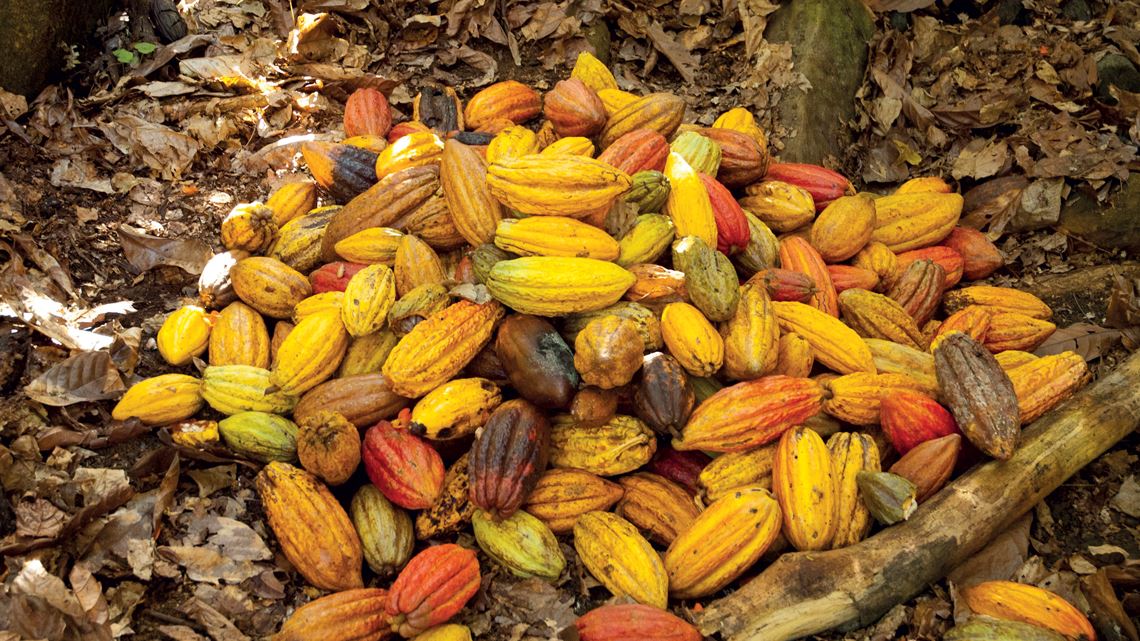
Eduardo Cesar
Cocoa grown in southern Bahia has been granted protected geographical indication status in Brazil
Eduardo CesarThe PDO recognizes the ancestral methods used by indigenous peoples to grow guarana and dry the seeds. The seeds are dried in earthen furnaces and then smoked to impart a unique flavor and help prevent spoilage. Guarana is largely grown in dark earths, a type of soil thought to be of anthropic origin, formed by organic residue left by successive human settlements. The high caffeine content in locally grown guarana, often higher than 5%, is partly attributed to cultivation in these types of soils. Guarana plantations are pollinated by stingless bees of the genus Scaptotrigona. The produce grown by indigenous groups is largely exported to Europe.
The Indian reservation PDO is the second geographical indication approved for Amazon guarana. In January 2019, another geographical indication, the Guaraná de Maués PGI, was created for an area adjacent to the Sateré-Mawé territory. As the name implies, the Maués PGI covers the entire area of this municipality except the portion within the indigenous territory. Maués guarana is similar to the guarana produced by the Sateré-Mawé, but there are a number of differences. “The guarana seedlings we plant here are supplied by EMBRAPA, whereas indigenous people typically prefer to use plants that are available in their territories,” explains Luca Dambros, vice chairman of the Maués Guarana Producers’ Association. “We also don’t smoke our guarana seeds after they have dried.” Maués produces around 300 metric tons of guarana per year across around 1,200 smallholder properties. “But only 2.5 metric tons carried the Maués PGI label last year,” says Dambros. “This year the figure should increase to 40 metric tons.” A major advantage for products carrying the Maués PGI label is that they can secure higher prices on the domestic market, up to about R$28 per kilo compared to the R$15 or R$20 for regular guarana.
Guarana is one of several Amazon products protected by geographical indications. Three regions producing cassava meal—Cruzeiro do Sul, in the state of Acre; Bragança, in the state of Pará; and Uarini, in the state of Amazonas—have recently been awarded geographical indication status. GI protection has also been awarded for Pirarucu fish harvested from an Amazon area managed by Instituto Mamirauá, an organization supported by the Brazilian Ministry of Science, Technology, and Innovation (MCTI); for cocoa grown in Tomé-Açu, in the state of Pará; and for a range of other products. Two geographical indications have also been awarded for cocoa grown in Linhares, Espírito Santo, and in southern Bahia. Fresh mangoes and grapes grown in the sub-middle São Francisco River basin, and melons grown in Mossoró, in Rio Grande do Norte, are two other examples of PGIs awarded for fruits.

Porto Digital
Porto Digital, in Recife, is the only geographical indication awarded in Brazil for services
Porto DigitalPottery and digital services
São Paulo State has two geographical indications for products not typically covered by this type of legal protection. One is for footwear produced in Franca. The other is for a ceramic artware hub in Porto Ferreira, which since the 2000s has received support from the Center for the Development of Functional Materials (CDMF), a FAPESP-funded Research, Innovation, and Dissemination Center (RIDC).
“In Porto Ferreira we retrofitted electric furnaces to natural gas ahead of the electricity crisis,” says Elson Longo, a professor emeritus of chemistry at the Federal University of São Carlos (UFSCAR), and a director at CDMF. “We also improved the ceramic clay mixture and its mechanical properties. In addition, we have provided one-off support to address problems involving pigments.”
No geographical indication is as unusual as the one awarded to Porto Digital, an information technology hub created in Recife roughly two decades ago. In 2012, it became the only applicant to be awarded GI protection for services. “The people at INPI were surprised by our application for PGI status, but they were very receptive and helpful throughout the process,” recalls Heraldo Ourem, head of innovation and competitiveness at Porto Digital.
The hub, a cluster of 350 software development companies that generated R$2.8 billion in revenue last year, is located in Recife Antigo (“Old Recife”), a historical section of central Recife located on an island bounded by the rivers Capibaribe and Beberibe and by the Atlantic Ocean, where the state capital of Pernambuco was first founded. “Our history, our geography, and our culture of innovation and social responsibility earned us the geographical indication,” says Ourem. Porto Digital’s pioneering application could lead other sectors—both products and services—to follow suit. To help consumers readily identify Brazilian PGI and PDO products, a Brazilian Geographical Indication Label has recently been created that can be used by all GIs.
Southern wine as a case in pointPerhaps because it was Brazil’s first geographical indication, or because it is part of an industry in which products are heavily associated with their region of origin, Vale dos Vinhedos has become Brazil’s most successful GI. Its history goes back to 1995 when the Vale dos Vinhedos Fine Wine Association (APROVALE) was founded and, with support from the Grape & Wine chapter of EMBRAPA and other partners, began a physical characterization assessment (climate, soil, and terrain) of the area and filed a GI application with the INPI.
“When GI protection was granted in 2002, the association had only a half-dozen members,” recalls Jaime Milan, a winemaking expert who previously served as director at APROVALE, and currently provides consulting services to this and other associations, as well as serving as chair of the Brazilian Association of Geographical Indications (ABRIG), created July this year. “Today, 26 vineyards and around 40 hospitality and retail establishments are members of APROVALE.”
On average, Vale dos Vinhedos produces 5 million bottles of fine wines and sparkling wines annually. That’s a relatively small volume—around 17% of the fine wines and 12% of the sparkling wines produced in Rio Grande do Sul, a state that accounts for 90% of Brazil’s wine output. But as shown by the number and profiles of APROVALE members, the geographic indication has helped businesses to flourish and thrive in the region, in tandem with the local tourism economy.
In 2001 there were 45,000 visitors to Vale dos Vinhedos. In 2019, the year before the COVID-19 pandemic, nearly half a million tourists visited the vineyards in the region. “Vale dos Vinhedos led the way for other geographical indications,” says Hulda Oliveira Giesbrecht, an innovation analyst at the Brazilian Micro and Small Business Support Service (SEBRAE), who heads the organization’s services to producers across different GI regions.
A European market worth €77 billion
Wikimedia Commons
Spanish
Serrano ham is among the 3,200 geographical indications in Europe
Wikimedia CommonsNowadopted all around the world, geographical indications were first introduced in Europe. Distinctive value-added products from countries such as France, Italy, Spain, and Portugal are produced within delimited areas and in accordance with a set of rules and practices applying to the different types of GIs. A study published this year by the European Commission placed the market value of Europe’s roughly 3,200 protected agricultural products at approximately €77 billion. Wines represented more than half of this figure. French and Italian products accounted for respectively a third and a fifth of Europe’s total production of GI products.
According to the Institut national de l’origine et de la qualité (INAO), France has 55 types of cheese protected by geographical indications, such as Camembert de Normandie, Brie de Meaux, Roquefort and Gruyère. Italy has a similar 56 GIs for cheese products, including Gorgonzola, Parmigiano Reggiano (Parmesan cheese), Grana Padano, and Pecorino Romano. In both France and Italy, the number of geographical indications for wines exceeds by far the number of days in the year.
Republish

